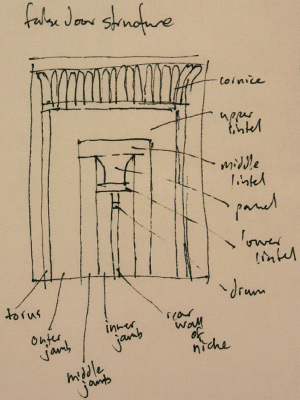the stelae,
which for the egyptians was a false door on a tomb, symbolically allowing
the soul to fly through, the stele had become a monument to the dead
in the memory of the living and was not endowed with 'the religious or magic
properties that invested the sepulchral art of most other civilizations'
—Honour. the magic false door that allowed the soul to fly through became but a tombstone. the magic was gone, the magic went underground
'As
an art form the sarcophagus had oriental, ancient Egyptian, and Etruscan
antecedents.' —Honour , 'Often shaped like a house with a pitched roof, it
provided a dwelling place for the deceased and implied beliefs about the
hereafter rather different from those held by the Greeks. But it was to
become the predominant art form in funerary sculpture from the late fourth
century BC through the Hellenistic and Roman eras right down to early Christian
times'
door, tomb, bench (table) : the egyptian false
door probably evolved from the external architecture of the Mastaba tombs
in the Early Dynastic period : not copies of real doors, but a stela and
offering niche with offering table : mastaba: an Arabic bench
around the time of unification of egypt, the dawn of the dynasties,
burial chambers were gradually cut deeper ... topped with a low mound, surrounded
by a low, rectangular mud-brick building : mastaba, from arabic 'low bench' : this structure gave way to subterranean storage, reached by
a stairway : Djoser's pyramid, with stepped appearance, is a development
of the mastaba tombs : interpreted as a symbolic mound of creation or stairway
to heaven : Djoser's architect, Imhotep, built in stages : the tomb started
as a square mastaba and five additional mastabas were added above to create
the first six-stepped pyramid
